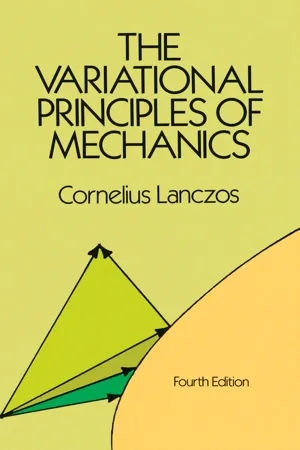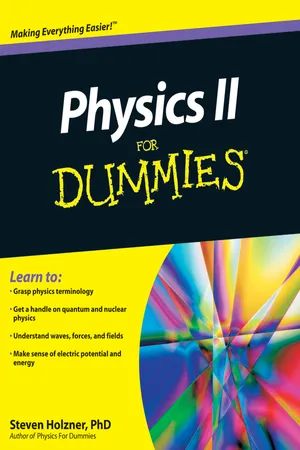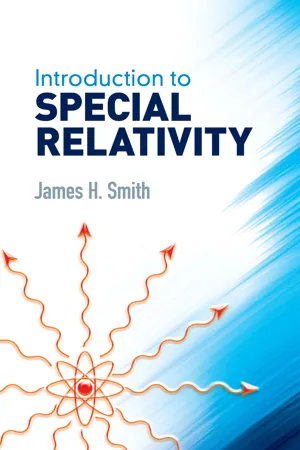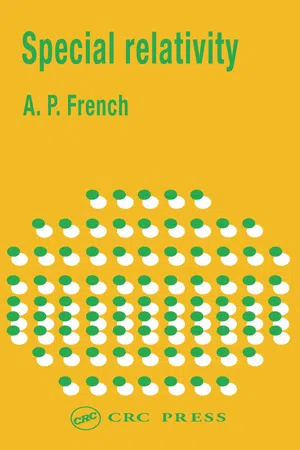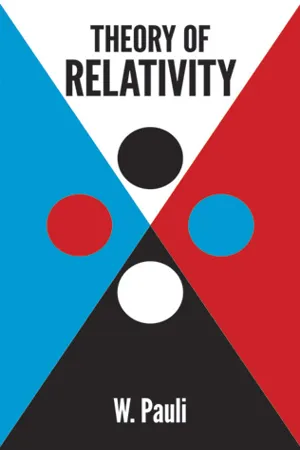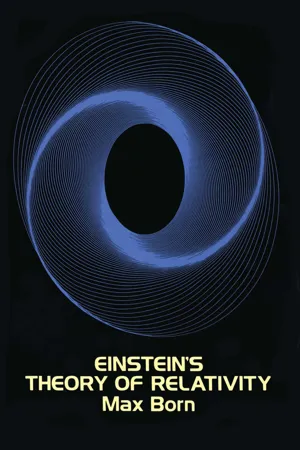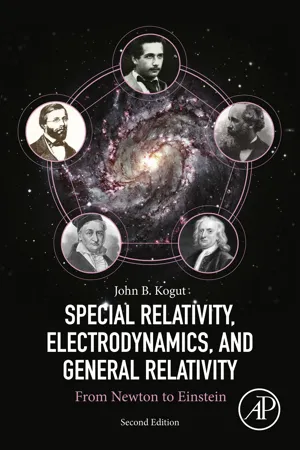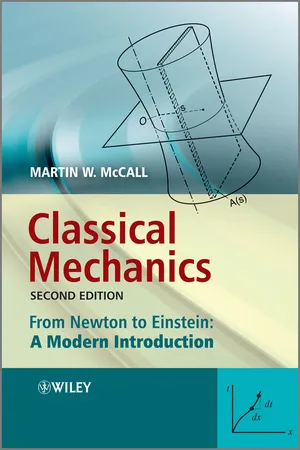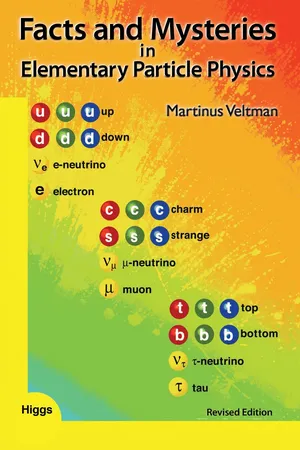Physics
Relativistic Momentum
Relativistic momentum is a concept in physics that describes the momentum of an object moving at speeds close to the speed of light. It takes into account the effects of special relativity, which means that the momentum of an object increases with its velocity, approaching infinity as the velocity approaches the speed of light. This concept is important for understanding the behavior of particles at high speeds.
Written by Perlego with AI-assistance
Related key terms
9 Key excerpts on "Relativistic Momentum"
- eBook - ePub
- Cornelius Lanczos(Author)
- 2012(Publication Date)
- Dover Publications(Publisher)
95.13 ):which establishes the 4-vector as the four-dimensional tangent vector (95.3 ) to the world-line of the particle, multiplied by the constant —mc.We see that the two Newtonian concepts momentum and energy, which in the Newtonian form of physics represent two separate entities, form relativistically an inseparable union; the components of the momentum (divided by i) plus the negative energy (divided by c) form together the components of a 4-vector of the Minkowskian space-time world.In the early relativistic literature it was customary to write the equation (95.11 ) in the formand to interpretas the “relativistic mass” of the particle, which changes with the velocity and increases to infinity as v approaches the velocity of light. This is useful for the demonstration that no finite force can ever accelerate a material body up to the velocity of light since the inertia of the body grows to infinity if v becomes c. But in actual fact the correction factor of the denominator belongs to dt, because we have to differentiate with respect to the arc- length s, which has an invariant significance, and not with respect to t, which is not more than one of the coordinates. Instead of the arc-length δ we can introduce a more physical quantity by defining the “proper time” of a particle. This is the time measured by a clock which is carried along by the particle and which is thus attached to the world-line of the particle. If this proper time is denoted by ρ we havesince the clock is permanently in a frame of reference in which the particle is at rest. In terms of this time we haveand if we agree that we define the velocity of a particle by the time rate of change of position, the time being measured in proper time, the definition (95.11 ) of the momentum becomesand Newton’s definition of the momentum remains unchanged.6. The Hamiltonian formulation of particle dynamics. - eBook - ePub
- Steven Holzner(Author)
- 2010(Publication Date)
- For Dummies(Publisher)
but the difference isn’t noticeable at slower speeds. So you can safely assume that the momentum and the Relativistic Momentum of a pool ball speeding across the table to a pocket are about the same.The difference starts becoming noticeable at higher speeds, of course. About the highest speeds that humans have been able to give to objects with mass are those reached in particle accelerators, which are those rings or linear tracks that physicists use to get particles like electrons moving at relativistic speeds.Classically, such electrons should only have a momentum ofThe speeds of electrons in those accelerators is very fast, pretty close to the speed of light. How close? At the Stanford Linear Accelerator Center (SLAC) in California, electrons are routinely goosed to speeds of 0.9999999997c. That fast enough for you? Physicists can get pretty speedy when they want to.p = mv= (9.11 × 10 –31 kg)(0.9999999997 c )= 2.7 × 10 –22 kg-m/sBut Einstein tells you that the electrons’ momentum is reallyNote that you may not be able to put all the digits of the electrons’ speed on your calculator, but if you look at Figure 12-4, you can see that the extra factor that appears in Relativistic Momentum becomes larger and larger as the speed approaches the speed of light.So although still tiny, the electrons’ momentum is a factor of That is, at relativistic speeds, the electrons’ momentum is 37,000 times what the momentum would be if the classical momentum held.Figure 12-4: The factor by which momentum is reduced in relativity.Note that different inertial reference frames can move at various speeds with respect to each other — and that means that momentum is not conserved between inertial reference frames. For example, a pool ball traveling slowly on the pool table may be seen as traveling very fast by a rocket-based observer — which means that the momentum you and the rocket observer measure would be different. - eBook - ePub
- James H. Smith(Author)
- 2016(Publication Date)
- Dover Publications(Publisher)
x-component of momentum in the unprimed frame of reference. This we have already assumed. However, if momentum is to be conserved in both frames of reference, the expression in the second parenthesis must also be zero. This means thatIn other words, the quantity , summed over all the particles, must be the same before and after the collision, i.e., it must be conserved. This should not be surprising. The requirement arises in exactly the same way that mass conservation did in the non-relativistic case. In fact, for low speeds, the quantity reduces to the mass of the particle. For this and other related reasons the quantity is often called the “mass” of a moving particle. We shall temporarily denote this “mass” by . In this case m would be referred to as the “rest mass” of the particle, the mass it would have when at rest. In this notation the Relativistic Momentum becomes , its classical form, and Equation 9-14 becomes simply the equation for conservation of “mass.”This “mass” of a particle increases with speed, and yet it is a quantity which has no direction associated with it. That is, it has no x-, y-, z-components; it is a scalar, not a vector. In these respects it resembles another classical quantity, the kinetic energy. The analogy is much closer than this, for if we expand the “mass” for cases where the speed is very small (see Appendix A ),If the equation were to be multiplied by c2 , the second term in the expansion would be the non-relativistic kinetic energy. Classically the first term, mc2 , would be a constant. Since additive constants never enter in calculations involving energy, which always depend on energy differences, the quantity has all the properties of the classical kinetic energy at low speeds.Multiplying Equation 9-14 by c2 does not materially affect it. Nevertheless, it states that the quantity is always conserved, unlike the classical kinetic energy that is not conserved in inelastic collisions, explosions, and the like. In this respect the quantity - eBook - ePub
- A.P. French(Author)
- 2017(Publication Date)
- CRC Press(Publisher)
7More about relativistic dynamicsIn relativity, we must complete the law of conservation of momentum by extending it to include the time component … The conservation of energy is the fourth equation which goes with the conservation of momentum to make a valid four-vector relationship in the geometry of space and time.R. P. Feynman, Lectures on Physics (1963)IN THIS CHAPTER we shall be discussing two main topics. The first of these is a more extended discussion of momentum and energy, with particular emphasis on the transformation of these quantities between two inertial frames. The second topic is the concept of force in relativistic dynamics—the way in which it is defined, its transformations, and the limitations on its usefulness. We begin with an important invariant that can be constructed from the measured values of momentum and energy in a given frame.An Energy-Momentum Invariant and its Use
The recipe for all that we have done so far is to assert that the energy and the linear momentum are separate constants for any self-contained system. In applying this, however, we take it for granted that we choose a particular inertial frame and stick to it throughout the calculation. What we shall do now is to ask ourselves how the measurements in different frames of E and p - eBook - ePub
- W. Pauli(Author)
- 2013(Publication Date)
- Dover Publications(Publisher)
which is in agreement with classical mechanics. The convenience of choosing the constant in this way becomes evident if we observe that the quantities are the components of a four-vector. For,It further follows that exactly the same transformation formulae hold for the G, E here as for the momentum and energy of a closed, force-free, electromagnetic system (light wave), cf. Eq. (228 ),with the corresponding inverse formulae. They are also valid for the momentum and energy of a system of freely moving particles.The equations of motion, and the expressions for momentum and energy, of relativistic mechanics go over into those of classical mechanics for small velocities, as was to be expected from the start. But we can go further than this: The deviations of relativistic from classical mechanics are of second order in v/c. This then must be the reason (as was pointed out by Laue214a ) why the older electron theory, which was based on classical mechanics, could explain all first-order effects correctly.Minkowski215 also gave a further important interpretation of the equations of motion (316 ). Let us introduce the kinetic energy-momentum tensor Θik by means of the relationIts space components represent the tensor of the momentum current, the mixed components (apart from a factor ic) the momentum density, and the time component the energy density. Because of the continuity conditionthe equations of motion can be written in the formIt should be pointed out here, that the equations of motion (317 ) result in a hyperbolic motion (discussed in § 26 ) for the case of a particle moving under a constant force.38. Relativistic mechanics on a basis independent of electrodynamicsThe derivation in the preceding section is unsatisfactory because it has to make use of electrodynamical concepts. An important contribution to the subject is therefore Lewis and Tolman’s215a derivation, which does not do so. There, the primary concept is not the force, but the momentum. They postulate that with each particle a momentum vector, parallel to its velocity, and a scalar kinetic energy can be associated in such a way that conservation laws - eBook - ePub
- Max Born(Author)
- 2012(Publication Date)
- Dover Publications(Publisher)
0 is a measure of the Einsteinian mass, but again, unlike the mass of ordinary mechanics, it is not, in an arbitrary system of reference, equal to the ratio of momentum to velocity or of force to acceleration.A glance at (formula 78 ) for the mass tells us that the values of the relativistic mass m become greater as the velocity v of the moving body approaches the velocity of light. For v = c the mass becomes infinitely great.From this it follows that it is impossible to make a body move with a velocity greater than that of light by applying forces: Its inertial resistance grows to an infinite extent and prevents the velocity of light from being reached.Here we see how Einstein's theory rounds off to a harmonious whole. The assumption that there is a limiting velocity that cannot be exceeded, which seems almost paradoxical, is itself required by the physical laws in their new form.(formula 78 ), giving the dependence of the mass on the velocity, is the same as that already found by Lorentz from electrodynamic calculations for his flattened electron. In it m0 was expressed in terms of the electrostatic energy S of the stationary electron just as in Abraham's theory (V , 13 , p. 211 , (formula 69 )), namely,We now see that Lorentz's formula for the dependency of mass on velocity has a much more general significance than is at first apparent. It must hold for every kind of mass, no matter whether it is of electro-dynamic origin or not.Experiments by Kaufmann (1901) and others who have deflected cathode rays by electric and magnetic fields have shown very accurately that the mass of electrons grows with velocity according to Lorentz's (formula 78 - eBook - ePub
Special Relativity, Electrodynamics, and General Relativity
From Newton to Einstein
- John B. Kogut(Author)
- 2018(Publication Date)
- Academic Press(Publisher)
Chapter 6Relativistic Dynamics
First Steps
Abstract
Einstein's relation E = mc 2 is derived from a “Gedanken” experiment. The generalization of energy and momentum to relativistic dynamics is obtained from the analysis of an inelastic collision where energy–momentum conservation and frame independence are required. The relativistic generalization of Newton's second law, which is consistent with the two postulates of relativity, is obtained. The energy–momentum four-vector is introduced and its transformation property under boosts is established. Covariant and contravariant four-vectors and tensors are introduced. The usefulness of invariants is stressed. Applications to relativistic collisions, where particles are created and destroyed, are discussed.Keywords
Conservation laws; Contravariant; Covariant; Energy–momentum; Four-vectors; Mössbauer effectContents6.1 Energy, Light, and E = mc 26.2 Patching Up Newtonian Dynamics—Relativistic Momentum and Energy 6.3 Relativistic Force and Energy Conservation 6.4 Energy and Momentum Conservation, and Four-Vectors 6.5 Focusing on Four-Vectors, Tensors, and Notation 6.6 Collisions and Conservation Laws—Converting Mass to Energy and Energy to Mass, Producing and Destroying Particles Problems References6.1. Energy, Light, and E = mc 2
We have spent all our time so far discussing how measurements of space–time coordinates transform between inertial frames in such a way that there is a universal speed limit. Has this been an empty exercise? We need to see that we can write down a scheme of relativistic dynamics - eBook - ePub
Classical Mechanics
From Newton to Einstein: A Modern Introduction
- Martin W. McCall(Author)
- 2011(Publication Date)
- Wiley(Publisher)
6 Relativity 2: Energy and MomentumActually, we cannot measure the length of real macroscopic objects since they are hard to accelerate up to relativistic speeds, and the ‘length’ of small particles is ill defined due to quantum effects. Time dilation in particle decays is significant as we have seen, but again, the twin paradox of Problem 5.8, though interesting to discuss, is not a technological possibility at present. So despite its aesthetic attraction, the role of space–time dilation is rather limited in terms of how relativity affects the ‘real’ world of experimental physics. The real experimental arena at present is in the high-energy particle physics laboratory and there, through recording particle tracks and detecting scintillations, it is the energy and momentum of particles that are measured. It is to these quantities that we must now turn.6.1 Energy and MomentumIf nothing can travel faster than light then, according to Newtonian theory, the momentum of a body is limited to p ≤ mc . In itself there is nothing seriously wrong with the notion that momentum is limited, although we might be uncomfortable with the idea that as we crank up the force on a body its momentum does not increase beyond a certain value. What is more serious is that experimentally, specifically in high-energy collisions, the total system momentum(6.1)is not conserved for an isolated system. Nor, in fact, is the total system kinetic energy(6.2)Recall, however, from Chapter 4, that the kinetic energy is only conserved if the interactions between bodies are ‘hard’, and do not dissipate energy into other forms (heat, electromagnetic, elastic, etc.). Although at the level of particle physics experiments it is harder to identify these ‘alternative’ sinks for energy in inelastic collisions, it may seem that violation of energy conservation is less of a problem than momentum conservation. So we have a dichotomy: either we must abandon the Newtonian expression for momentum, or we must redefine momentum in such a way that it is conserved. This cuts right through the middle of Newton’s laws, for we saw in Chapter 1 that the conservation of momentum for isolated systems was an emergent property of the second law. Newtonian physics is in serious trouble if we are going to attempt to maintain the conservation of momentum for isolated systems. Now that we are faced with the possibility of abandoning Newtonian momentum, once again the issues over the role of definition and physical law, discussed in Section 1.5, rear their head again. If momentum is going to be defined to be a quantity that is conserved in high-speed collisions (with the additional requirement that it reduces to Newtonian momentum for low speeds) then is not our reasoning circular? No! The point is that one experiment is not enough. The first experiment can be used to define, or propose, an expression for momentum that satisfies the Newtonian limit condition and is conserved in that experiment. Now we can perform additional experiments to see if momentum so defined is conserved in general - Martinus J G Veltman(Author)
- 2018(Publication Date)
- WSPC(Publisher)
When asked: “What is your nationality?”, Einstein answered: “That will be decided only after my death. If my theories are borne out by experiment, the Germans will say that I was a German and the French will say that I was a Jew. If they are not confirmed, the Germans will say that I was a Jew and the French will say that I was a German.” In actual fact, Einstein kept his Swiss nationality until his death, in addition to his US citizenship.In the figure the dashed curve shows the energy versus the velocity in the pre-relativistic theory, the solid curve shows the same relationship in today’s theory. In experimental particle physics one practically always deals with ultra-relativistic particles, with speeds within a fraction of a percent (such as 1/100%) from the speed of light. It is clearly better to work directly with momentum rather than with velocity.The relation between energy and momentum changes much less dramatically when passing from the pre-relativistic formulation to the relativistic theory. In fact, the energy increases less sharply with momentum, and for very high values of the momentum the energy becomes proportional to it. (Energy approximately equals momentum times c, the speed of light.) A typical case is shown in the next figure, with the dashed line showing the non-relativistic case, the solid curve the relativistically correct relation.The quantitatively minded reader may be reminded of the equations quoted in Chapter 1 . In particular there is the relation between energy and momentum, plotted in the next figure:or, using the choice of units such that c = 1:Another important fact is the Einstein equation E = mc2 . This very famous equation can be deduced in a number of ways, none of which is intuitively appealing. This equation tells us that even for a particle at rest the energy is not zero, but equal to its mass multiplied with the square of the speed of light. In particle physics this equation is a fact of daily life, because in inelastic processes, where the set of secondary particles is different from the primary one, there is no energy conservation unless one includes these rest-mass energies in the calculation. As the final particles have generally masses different from the primary ones, the mass-energy of the initial state is in general different from that of the final state. In fact, the first example that has already been discussed extensively is neutron decay; this decay is a beautiful and direct demonstration of Einstein’s law, E = mc2
Index pages curate the most relevant extracts from our library of academic textbooks. They’ve been created using an in-house natural language model (NLM), each adding context and meaning to key research topics.
